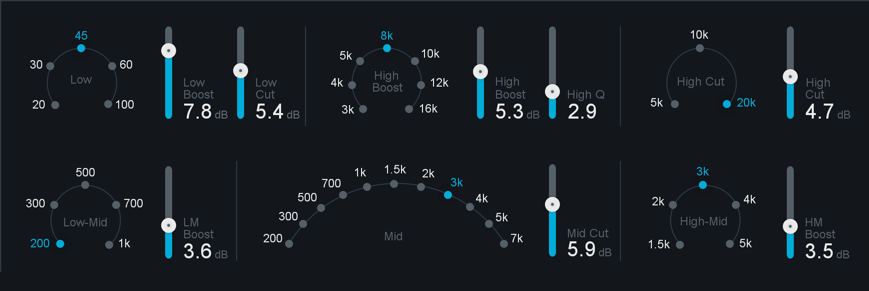Vintage EQ
Table of Contents
Overview
The Vintage EQ module can be used to add the emulated frequency response of the Pultec EQP-1A and Pultec MEQ-5. The module interface is divided into the following sections:

Module Header
The module header area includes the following controls:

- Channel Processing Modes: Selects the channel processing mode used by the Vintage EQ.
- The Vintage EQ supports Stereo, Mid/Side, and Left/Right channel processing modes.
- See the General Controls chapter for more information.
- Reset: Returns all module controls to their default values.
Spectrum and EQ Curve
The Vintage EQ module includes a spectrum analyzer and a composite EQ curve.

- Spectrum Analyzer: Displays the magnitude (amplitude, in decibels) of a signal across the frequency spectrum in real-time. The spectrum analyzer in the Equalizer module displays the output signal of Ozone.
- Composite curve: The combined filter response of all bands. Represented by a thick white line drawn across the spectrum. Each band contributes to the overall shape of this curve.
Controls
The Vintage EQ control panel includes two sections of controls. The controls along the top are modeled after the Pultec EQP-1A Equalizer and the controls along the bottom are modeled after the Pultec MEQ-5 Equalizer.

Pultec EQP-1A Controls
The top row of controls includes filters modeled after the Pultec EQP-1A.

A unique feature of the Pultec EQP-1A is the ability to simultaneously adjust the boost and cut parameters for the low frequency band. While the original manual warns “Do not attempt to boost and attenuate simultaneously,” these controls interact in a way that many engineers have found to be desirable. Rather than canceling each other out, combining these controls results in a boost in the low frequencies, followed by a dip at slightly higher frequencies. This unique shape is also available in the Ozone Equalizer module with the “Vintage Low Shelf” filter shape.
Low Boost/Cut Controls
- Low Frequency (Hz): Sets the frequency of the low shelf filter. Options include: 20 Hz, 30 Hz, 45 Hz, 60
Hz, and 100 Hz.
45 Hz option
The original hardware unit did not include a 45 Hz option, but we’ve added this frequency because we found it to be useful for mastering.
- Low Boost (dB): Adjusts the amount of positive gain (boost) applied to the filter.
- Low Cut (dB): Adjusts the amount of negative gain (cut) applied to the filter.
High Boost Controls
- High Boost Frequency (Hz): Sets the center frequency of the high boost peaking filter. Options include: 3 kHz, 4 kHz, 5 kHz, 8 kHz, 10 kHz, 12 kHz, and 16 kHz.
- High Boost Amount (dB): Adjusts the amount of positive gain (boost) applied to the filter.
- High Boost Q: Adjusts the bandwidth of the high frequency boost filter. The boost amount and bandwidth interact (i.e. the Q changes as you boost), as they do in the EQP-1A.
High Cut Controls
- High Cut Frequency (Hz): Sets the frequency of the high shelf filter. Options include: 5 kHz, 10 kHz, and 20kHz.
- High Cut (dB): Adjusts the amount of negative gain (cut) applied to the filter.
Pultec MEQ-5 Equalizer Controls
The bottom row of controls includes filters modeled after the Pultec MEQ-5.

All of the mid frequency controls are peaking filters. As in the original MEQ-5, the filter bandwidths are affected by the boost/cut amount.
Low-Mid Controls
- Low-Mid Frequency (Hz): Sets the center frequency of the low-mid peaking filter. Options include: 200 Hz, 300 Hz, 500 Hz, 700 Hz, and 1000 Hz.
- LM Boost (dB): Adjusts the amount of positive gain (boost) applied to the filter.
Mid Controls
- Mid Cut Frequency (Hz): Sets the center frequency of the Mid peaking filter. Options include: 200 Hz, 300 Hz, 500 Hz, 700 Hz, 1 kHz, 1.5 kHz, 2 kHz, 3 kHz, 4 kHz, 5 kHz, and 7 kHz.
- Mid Cut (dB): Adjusts the amount of negative gain (cut) applied to the filter.
High-Mid Controls
- High-Mid Frequency (Hz): Sets the center frequency of the high-mid filter. Options include 1.5 kHz, 2 kHz, 3 kHz, 4 kHz, and 5 kHz.
- HM Boost (dB): Sets the amount of positive gain (boost) applied to the filter.